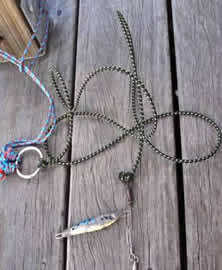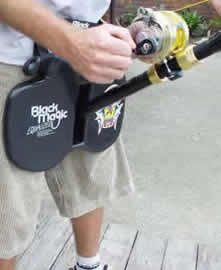02: Basic Angler Training
Between The Lines - Ch 08: Training
|
Learning how to use a game outfit on shore to prepare for battle can be lots of fun. Although it is certainly better to get your whole fishing team, or even fishing club involved, you can practice these exercises on your own. While these exercises involve the use of stand-up tackle, they are just as valuable to anglers who use heavy tackle chair outfits. The following exercises will take a complete novice from zero to hero with little effort and time. It is actually harder for an angler with some experience as they may have preconceived ideas and developed methods which have become a habit. In previous exercises such as when we spooled up and set drags there has been no emphasis on pumping the rod that is, the importance of lifting and lowering it. This set of exercises involve a game outfit of 8-15kg, gimbal belt and harness, a length of shock cord, about 10-feet long, with a snap swivel at one end and a length of rope tied to the other. The bungy should be thick enough to stretch on the line class used from around 20 to 100 percent of the breaking strain used. Take care the knots in the bungy and rope are secure and will not slip under load. You can also put something such as an old casting lure or small bell on the snap to show movement. To set up for the first exercise secure the bungy rope (Fig 1) to something very solid such as a fence pole and connect your outfit via the snap swivel to the bungy. (Fig 2)
The angler puts on the gimbal, but not the harness at this stage. (Fig 3) Get around 15-feet of line out between the angler and the end of the bungy. Finally, put the rod in the gimbal and start pumping the rod, that is, lifting the rod to gain line although in these exercises you’ll lose line on the upstroke, lowering to wind on line. Set the drag so the bungy stretches, but not high enough to extend it to its maximum length. The purpose of this exercise is to get the angler to have a smooth action that maintains pressure at a steady rate through the pumping action. The idea is to try and get that little lure or bell to move as little as possible. When you start, it will probably look something like this. (Vid 1)
There are several things that can be done to improve pumping action. Adjust the arc through which the rod travels, the narrower the arc the less the bungy will move, but the less line will be recovered with each pump. You may find that the arc between 9.30 and 11 o’clock is about right. The beauty of this system is that it ends up being a combination of what suits the individual most such as the way to hold the rod and reel handle and how high up the foregrip to hold the rod and where to position the gimbals etc. There really is no definitive best way of achieving any of this.
Once we have mastered the pump and got the little fish or bell on the bungy to hold steady we look at a few other aspects. For example, is the angler holding the rod and reel in a death grip that will tire them quickly? This is easily fixed by putting a raw egg in each hand and then continuing the exercise without breaking the eggs. (Fig 4) It is a good idea to do this exercise outside and not in a carpeted room. Generally, with this exercise, anglers slow down their action dramatically. It is important to note that you can still raise and drop the rod very quickly while still being very smooth and for many real life situations this is an ability worth having. Another improvement in the system is that the rod should be raised and lowered at the same speed as this will keep the fish moving steadily. One of the greatest concerns is comfort, as this exercise replicates fighting a fish which in many instances could be for quite some time, so once you have mastered the exercise you should try it on your normal fighting drag for as long as you can hold out as you will then know what your capacity is. During this extended exercise try several different stances and holding the reel and rod in different grips. You will find that there are several muscle groups that you can use while resting others which will aid in extending your fighting time. In reality, when you are hooked up to a fish, adrenalin will certainly compensate for tired aching muscles which will extend your fighting time somewhat. For the second part of this exercise, the only difference is adding a harness. (fig 5) The exercises are the same as in the previous example. The stance is slightly different. Here the left arm is not used to hold the rod at all, that’s what the harness is for. The left hand is placed over the reel, with a slight bit of pressure pushing the outfit away from you. This helps stabilise the rod and also protects you from the rod flying back into your face if the line breaks when it is loaded. Note that the left hand is also used to level the line on the spool. Pumping the rod when wearing a harness involves rocking backwards and forwards against the pressure of the rod which will lift and lower it. This motion can be used in conjunction with or instead of bending the knees (fig 6) which will also raise and lower the rod. Note that regardless of the size and strength of the angler and the size and strength of the tackle in all cases you will find it much easier to maintain steady pressure with the outfit using a gimbal and harness. By the time you have finished (Vid 3) this exercise, you will have adjusted the gimbal and harness to be both most effective and comfortable for you. Take note of how it all feels so that you can replicate the strap adjustments and positions on the boat. Due to the fact you will be wearing different thicknesses of clothing, marking the straps in their positions can only be used as a rough guide. Certainly each time an angler goes on strike these adjustments should be checked.
|








